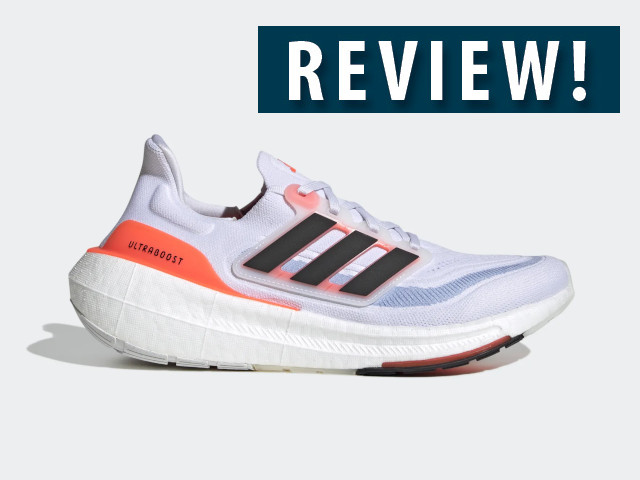In the fast-paced world of running tech, it’s great to see that Adidas’s Boost tech has survived a full ten years. When it was first introduced in 2013, it caused a stir in the running world, being one of the first offering decent energy return on every footfall. I ran with the second iteration of these shoes – the Adidas Energy Boost 2 (review) – for a long time and really enjoyed my runs.
Ultraboost also found massive popularity amongst the sneaker crowd while perhaps getting less attractive to runners over time. The past few iterations of the shoe were heavy, this as their competitors have become lighter.
Now Adidas is back with new Boost tech they claim is 30% lighter, found on the new Ultraboost Light running shoe. Indeed, the new shoe weighs 293 g (UK 8.5) compared to the previous version’s chunky 333 g.
While the style of the Ultraboost range might be well established, the question many runners will ask is how does the new Light version perform on the road, and does it do enough to win back runners’ hearts?
Style and Uppers
Adidas stuck with what works, with not many changes to this well-liked silhouette. You’ll find more protection around the top heel area of the Ultraboost Light, with the bottom rung of the lace area now incorporated into the PVA lacing strip like the rest of the holes.
On foot the Ultraboost Light feels snug and I would recommend either going half a size or a full size up from normal. The sock-like upper keeps your foot locked in, almost to the point where you don’t even need to tie the laces. As far as uppers, the adidas PRIMEKNIT+ textile sock-like upper feels decently thick although perhaps less breathable since it’s quite densely knit.
The heel-area on the Ultraboost Light is padded on the side, with a heel-cage formed by a thick plastic around the outside. I never experienced any chaffing on the achilles, with the heel-lip also protruding to help when putting these on.
New midsole tech on the road
The most noticeable of changes are on the midsole, with the bubbled texture of the previous Ultraboost tech making way for an almost industrial looking midsole. It has a polystyrene packaging feel to it, which in no way is said disparagingly since it certainly adds to a unique look and feel.
The proof, however, is in the pudding, and when taking the Adidas Ultraboost Light to tarmac, I was pleasantly surprised, more so the longer I ran in them.
The Ultraboost Light offers a wide and thick (30mm) midsole underneath the heel, which combines really well with the Adidas Linear Energy Push (LPS) system and grooved outsole. A centre groove basically splits the support underneath the heel between the left and the right. The result is a well-supported run, with the foot not able to either excessively pronate or supinate. The heel strike felt smooth, with the heel cage offering stability to guide the foot comfortably along to toe-off.
The Ultraboost Light foam is bouncy when it needs to be without being unwieldy. On longer runs you’ll be well supported around the heel, while sprints and fartlek sessions sees the LPS system pulling its weight by adding a bit more stiffness in the midfoot and front foot area, although no carbon plate is present for extra energy return.
No drift on the Continental outsole
Continental Better Rubber can be found on the outsole offering decent traction, however towards the heel the compound changes to what appears to be a softer rubber which wears easier. Part of the LEP system remains exposed underneath, which once meant a pebble scraping its way against the hardened plastic, although this was far from a constant problem.
As mentioned, at 30mm thick the side of the heel is well protected, but the groove down the centre of the outsole leaves an exposed underbelly of only a thin layer of Ultraboost foam to protect the shoe from rocks and the like. For this reason, the Ultraboost Light might be best left off the trail. While I did run a bit of trail here and there, I also felt stability was lacking.
One thing to mention is that even though Adidas calls it the Ultraboost Light, this version is lighter than previous versions of the Ultraboost model (about 30% so), but not so much compared to other running shoes. For example, at 323 g for the UK10, it’s heavier than the 286 g of the Puma Velocity Nitro 2 (review) or Under Armour’s Sonic 4 (review) at 281g. It falls more in line with the Puma Magnify Nitro 2 (323 g), which places it more towards the heavier side of shoes we’ve tested. However, if you were put off by the excessive weight of the previous Ultraboost versions, now is certainly the time to reconsider.
Thoughts and Feelings
At the end of the day the Adidas Ultraboost Light really surprised me as a decent performing running shoe. It’s a fun shoe to run in and the way it guides you on foot to offer a well-regulated running gait will be a big benefit to those looking for stability.
It’s easy to recommend the Ultraboost Light for up to 21km on race day, while as a daily trainer you will end up enjoying both slow and faster paced runs. And the Ultraboost Light will most certainly cope with cardio sessions in the gym, almost to the point of overkill.
It will be best to find the right fit in store, while it's perhaps true that the Ultraboost Light is not as light as the competitors.
If you’ve been ignoring the Ultraboost range, the Ultraboost Light offers you enough reason to reconsider, bringing stability without sacrificing power. However, the Ultraboost range still demands a premium, which for the Ultraboost Light stands at a solid R3 500 dent to your credit.




